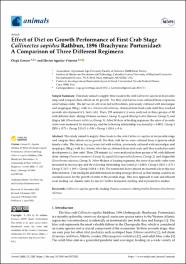Effect of Diet on Growth Performance of First Crab Stage Callinectes sapidus Rathbun, 1896 (Brachyura: Portunidae): A Comparison of Three Different Regimens

View/
Download
(application/pdf: 420.6Kb)
(application/pdf: 420.6Kb)
Date
2023-04-03Author(s)
Gencer, Övgü
Aguilar Vitorino, Hector
Metadata
Show full item recordAbstract
“This study aimed to supply three foods to the crab Callinectes sapidus in its juvenile stage
and compare their effects on its growth. For that, crab larvae were cultured from oviparous adult
female crabs. The larvae (z1–z8) were fed with rotifers, previously cultured with microalgae and
megalopae (Meg.) with live Artemia salina larvae, obtained from fresh cysts until they reached juvenile
development (c1, first crab). Then, 270 animals (c1) were analyzed in three groups of 90, with different
diets: shrimp (Penaeus vannamei; Group 1), squid (Mastigoteuthis flammea; Group 2), and tilapia fish
(Oreochromis niloticus; Group 3). After 90 days of feeding regimens, the sizes of juvenile crabs were
measured by microscopy, and the following relationship was found (p < 0.001): Group 1 (20.8 0.7) >
Group 2 (14.5 0.9) > Group 3 (10.4 0.6). The nutritional factor played an essential role in this size
differentiation. This intelligent and differentiated feeding strategy showed us that shrimp could be an
essential source for the growth of crabs in the juvenile stage. This new approach to safe and efficient
roost feeding can classify crabs by size for further hormonal, molting, and reproductive studies.“
Collections
- SCOPUS [380]

